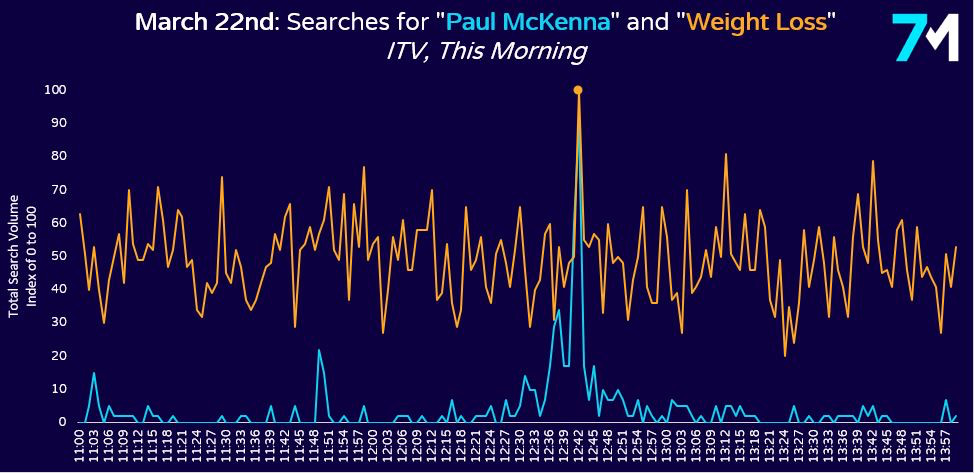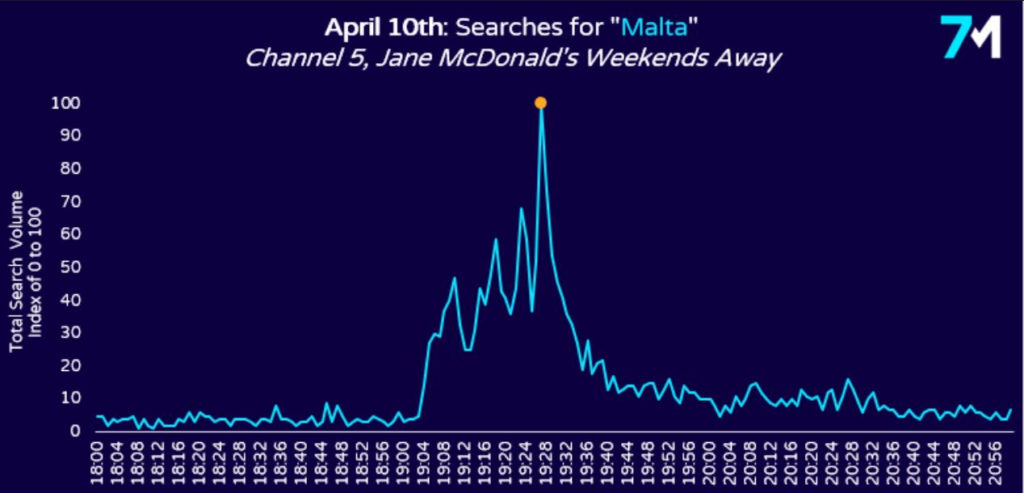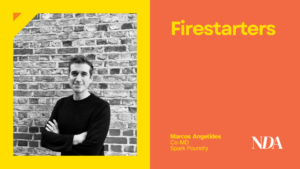John Byrne, Head of Data and Insights, 7th Minute
At 11:42am on Friday March 22nd 2021, there was a spike in online searches for two terms. Renowned hypnotherapist ‘Paul McKenna’, and ‘weight loss’.

But it’s not Paul’s hypnotic power that caused the nation to search simultaneously.
It’s all down to TV.
At that moment there was a segment on ITV’s This Morning that featured Paul using his skills to attempt hypnotic weight loss therapy on a caller to the show – and viewers, wanting to know more, went online to find out. This spike is good news for Paul, but perhaps even better news for the many companies in the weight loss industry.
In a similar vein, around 19:27pm on April 10th 2021, an episode of Jane McDonald’s Weekends Away that featured Malta caused an increase in people searching for – you’ve guessed it – Malta. This is key audience information for travel companies that cover the Mediterranean.

These spikes in interest – and potential demand – occur all the time across industries, TV channels and TV shows.
So why is this important for advertisers?
The power of now
When budgets are limited and an ‘always on’ strategy isn’t feasible, which is the reality for many brands, having insight into when their offering might be front of mind for potential consumers is hugely powerful. Advertising activity that is short and sharp – but timely – is highly effective, with our research indicating that digital interest reaches its peak around seven minutes after an ‘event’.
Brands that know exactly when they, or a relevant topic, are mentioned and can respond with a digital ad within the seven-minute timeframe (or thereabouts) elevate the likelihood of a positive reaction (potentially a purchase).
This is moment marketing, which does what it says on the tin; it puts a message in front of someone at a moment when they are highly likely to be engaged with the topic or brand. In other words, it uses an event, whether external or online, to do a lot of the heavy lifting.
Someone opening Facebook on their phone while they watch This Morning and seeing an ad for a diet-related product a few minutes after they’ve viewed the feature on weight loss via hypnotherapy is primed to buy that item, or at least find out more, because their interest has already been piqued.
In a world where the increasingly finite shelf-life of third-party cookies sees attention turning to context, this tactic has obvious appeal.
But moment marketing is not new.
Oreo’s ‘Power out? No problem. You can still dunk in the dark’ social media messages at the 2013 Super Bowl when an unexpected power outage stopped play is widely used as an example of how brands can make unscheduled events work in their favour.
The power of technology
What has changed however is that automation technology is increasingly able to provide the real-time insight and activation that brands need to respond effectively. (In 2013, Oreo had an extensive social media team ready to provide commentary during the game.)
Advances in automated content recognition (ACR) are a major factor; images from TV programmes and ad breaks are turned into data which is far more usable from an insight perspective. Broadcast content can now be processed, subtitled and organised, giving advertisers contextual data to inform their actions.
This extends to understanding nuances such as how reaction times differ depending on the programme and the platform; during an episode of The Masked Singer for example, Twitter activity peaked as the singers were revealed and viewers tweeted in excitement before the show started, but search was at its highest at the end when viewers wanted to find out more. Granular details of this nature can give advertisers the clout that is the difference between an ad generating a reaction and falling on deaf ears, or perhaps more accurately, blind eyes.
‘Seven minutes’ is admittedly a sometimes arbitrary figure; what it does convey however is that moment marketing is all about timing; advertisers need to be fast and they need to be informed about when an event occurs, how their audiences respond to it and what they can do to make the most of this reaction.










